|
|
|
Sort Order |
|
|
|
Items / Page
|
|
|
|
|
|
|
| Srl | Item |
| 1 |
ID:
159536
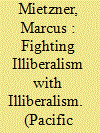

|
|
|
|
|
| Summary/Abstract |
The global rise of populist campaigns against democratic governments has revived the long-standing scholarly debate on how democracies can best defend themselves against anti-democratic challenges. While some view an aggressive militant democracy approach as the most effective option, others propose accommodation of populist actors and voters. Others again suggest a merging of the two paradigms. This article analyzes how the government of Indonesian President Jokowi has responded to the unprecedented Islamist-populist mobilization in the capital Jakarta in late 2016. Unsystematically mixing elements of all available options, Jokowi’s administration pursued a criminalization strategy against populists that violated established legal norms, and launched vaguely targeted but patronage-oriented accommodation policies. As a result, the government’s attempt to protect the democratic status quo from populist attacks turned into a threat to democracy itself. Indonesian democracy, I argue, is now in a slow but perceptible process of deconsolidation.
|
|
|
|
|
|
|
|
|
|
|
|
|
|
|
|
| 2 |
ID:
159534
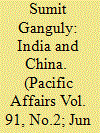

|
|
|
|
|
| Summary/Abstract |
Sino-Indian relations, which have long been fraught, took an especially adverse turn this summer with a military-to-military confrontation on the Doklam Plateau near the India-Bhutan-Tibet trijunction. After several weeks, Indian and Chinese forces withdrew from the region. However, neither side resiled from their respective territorial claims. This episode exemplified the troubles that have come to characterize the Sino-Indian relationship, especially since Prime Minister Modi assumed office in 2014. His regime, which is more nationalistic and reposes greater faith in the utility of force in international politics, had initially sought to diplomatically court the PRC in the hopes of improving their bilateral relationship. However, these efforts did not prove successful. Instead, the People’s Liberation Army, as in the past, continued to undertake limited probes along the Himalayan border, while the PRC continued to make diplomatic, commercial, and strategic inroads into India’s neighbours, trying to reduce India’s influence in those countries. The Modi regime, in turn, sought to counter these initiatives through various efforts of its own in the neighbourhood. Beyond South Asia, India has also sought to enhance its ties with Australia, Japan, the United States, and Vietnam in an attempt to hedge against the PRC’s growing economic and military assertiveness in Asia. These endeavours, however, have elicited hostile reactions from Beijing, which sees New Delhi as the only significant potential hurdle to the expansion of its influence in Asia. Despite Beijing’s adverse reactions it is unlikely that the current regime in New Delhi will scale back its efforts to cope with what it deems to be significant threats emanating from its behemoth northern neighbour.
|
|
|
|
|
|
|
|
|
|
|
|
|
|
|
|
| 3 |
ID:
159535
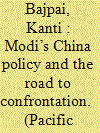

|
|
|
|
|
| Summary/Abstract |
The Doklam confrontation between India and China in the summer of 2017 was symbolic of the brewing tensions in their relationship. While the confrontation was resolved peacefully, its roots go back at least to 2007. Both the Manmohan Singh government and the Narendra Modi government pushed back against what they perceived to be a series of moves on bilateral, regional, and international issues that went against Indian interests. Modi’s responses have been more aggressive than Manmohan Singh’s in two ways. First, under Modi, India has more openly than ever before attempted to construct a coalition of militarily powerful states in the Asia-Pacific to increase Delhi’s bargaining power with Beijing. Second, India has sought to change the terms of engagement on the border conflict in three respects: a return to clarification of the Line of Actual Control (LAC) as the first step in border negotiations; linking further normalization between the two countries to progress towards a final border settlement; and seeking to inject a greater sense of urgency in the search for a settlement. This article concludes by asking why Modi responded more aggressively to China. It presents four explanations and concludes that Modi’s election in May 2014 coincided with a growing sense of strategic exasperation in India over its China policy, which questioned the value of the post-1988 commitment to normalization. The paper suggests that Modi shared that sense of exasperation, hence the rapid change in India’s stance within months of his coming to power.
|
|
|
|
|
|
|
|
|
|
|
|
|
|
|
|
| 4 |
ID:
159537
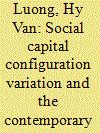

|
|
|
|
|
| Summary/Abstract |
This article examines the contemporary transformation of rural Vietnam in relation to market economy dynamics and regionally varying configurations of social capital. It is based on the author’s longitudinal and panel study of seven Vietnamese lowland communities (two in the north, two in the mid-central coast, and three in the southern Mekong Delta) over a decade in the twenty-first century. Living standards in the rural Vietnamese lowlands have increased significantly thanks mainly to migration, industrial production dispersal to smaller provinces, and the higher wages in rural communities that have resulted from reduced labour supply. However, per capita income has generally increased faster in communities in the northern delta and the central coast than in those of the Mekong Delta. This article suggests that the differences in social capital configuration between the northern Red River Delta and the central coast on the one hand, and in the southern Mekong Delta on the other, have contributed to the faster per capita income growth in the former.
|
|
|
|
|
|
|
|
|
|
|
|
|
|
|
|
| 5 |
ID:
159538
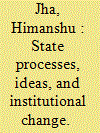

|
|
|
|
|
| Summary/Abstract |
Historically, the Indian state has embraced the norm of secrecy. Yet despite this legacy, in 2005 India passed the Right to Information Act (RTIA). What explains this institutional change in India’s information regime? The mainstream literature overlooks significant historical evidence, which I deploy to demonstrate that ideas on openness emerged as part of the opposition politics within the state after independence in 1947, gradually and incrementally became part of mainstream politics, and eventually led to the RTIA. I propose a largely endogenous model of institutional change that builds on gradual changes to finally reach a threshold—or tipping point.
|
|
|
|
|
|
|
|
|
|
|
|
|
|
|
|
|
|
|
|
|